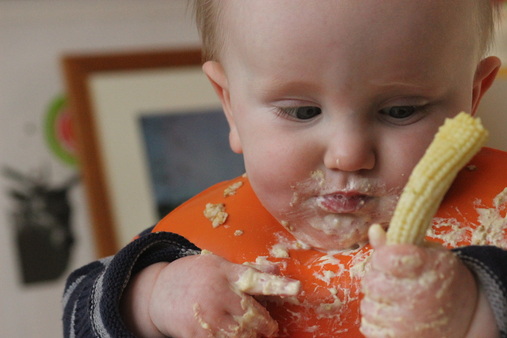 For the first few months of their lives, babies can’t do much. In the first video I filmed of my son, when he was three weeks old, he struggles for several minutes just to turn his head from one side to the other. Imagine my skepticism, then, when I learned about “baby-led weaning” or “BLW”. The American Academy of Pediatrics recommends that you start giving your child solid “complimentary” foods, in addition to breast milk or formula, when he reaches 6 months of age. Instead of starting with “baby” food – rice cereal, fruit and vegetable purees – devotees of baby-led weaning call for feeding babies small pieces of “real” food, allowing babies to feed themselves. Popularized by British author Gil Rapley with the slogan “The Mush Stops Here,” proponents claim that BLW spares parents the hassle of buying or making baby food, introduces babies to a wider variety of tastes and textures, and allows them to recognize their own hunger signals and stop eating when they’re full. Critics of baby-led weaning argue that it can be difficult to tell if a self-fed baby is eating enough food or receiving appropriate nutrients, and that feeding young babies pieces of solid food is a choking hazard. Not to mention messy -- even Rapley acknowledges that most of a BLW-fed baby’s meal may end up “smushed into the nearest curtain.”
So what, if anything, do scientists have to say about how best to introduce your baby to solid foods? There are a few studies examining baby-led weaning, mostly from the United Kingdom. For example, one study concluded that most (though not all) babies were capable of self-feeding by 8 months of age. Another study of 155 babies found that self-fed infants had lower body mass index and were less likely to prefer sweeter foods than their spoon-fed counterparts . (This study should be interpreted with some caution, as it relied on parents’ recollections of their children’s diets and food preferences.) A review of studies on baby-led weaning concluded that baby-led weaning “could conceivably have beneficial effects on the infant’s nutrition and development.” The same authors concluded that a randomized controlled trial was needed to get more definitive answers. In my own personal study of infant feeding practices (sample size: 1), my son took to baby rice cereal and vegetable purees like the proverbial duck to water. A few weeks later, at 8 months old, he shoved a fistful of rice and beans from my dinner plate into his mouth and went back for seconds. After consulting with his pediatrician, we’ve adopted a “WBWET” approach – “Whatever Baby Will Eat Today.” Sometimes that’s yogurt or mashed fruit from a spoon; sometimes it’s pieces of banana or Cheerios that he feeds himself. Last night it was bits of leftover pasta with peas and cheese, served on a high chair tray with an eager dog whining at his feet (which does help with the messiness of a self-fed infant). For now, we’ll see where baby leads us.
0 Comments
Your comment will be posted after it is approved.
Leave a Reply. |
©2017 WeighingInBlog. All rights reserved. 401 Park Drive, Boston, MA




 RSS Feed
RSS Feed

